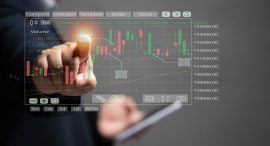
Leverage is an important concept in trading. But many traders don’t have a solid grasp of what leverage means. Here’s a look at the leverage meaning, how it works in trading, and some of the pros and cons of this often-risky strategy.

Leverage Meaning
How do you define leverage? In the physical world, a lever involves putting a beam or arm over a fulcrum. By placing pressure on the beam further away from the fulcrum, you can exert significant upward force.
When it comes to trading, the leverage meaning is similar. When you use leverage, you borrow money (usually from a broker or platform) to access larger positions. This means that you can effectively invest much more money.
For example, imagine that you have $2,000 in a trading account. With enough leverage, you can control a position of $20,000. So why use leverage?
The answer is simple. Because leverage amplifies the value of your actual trade, it can multiply your returns as well. However, it’s incredibly risky, as it can also amplify your losses.
How Does Trading With Leverage Work?
Are you unsure how to define leverage? The best way to understand the leverage meaning and how it works is by looking at an example. Imagine that you have $10,000 to trade, and there’s a stock you’re interested in buying for $100 per share.
Even if you invest all $10,000, you can only get 100 shares. You want more, so you decide to borrow $10,000. This means you have $20,000 total to invest, and you can get 200 shares instead of 100. Because you were able to invest twice the amount of what you had, your leverage ratio is 2:1.
The exact way leverage works depends on what you use for collateral, the amount in your account, the broker you work with, and whether you’re trading stocks, forex, etc. There are some general points about leverage to keep in mind.
For instance, in most cases, you need to have at least half of the price of the investment in your account. Thus, if you want to borrow $4,000 as leverage, you’d need at least $2,000.
Additionally, some brokers may require you to have more than half the investment price in your account. You should also know that the leverage you can get with stock trades is usually fairly minimal. However, in the risky forex market, you can sometimes get as much as 100:1 leverage.
Just as you should be familiar with leverage in general, you should also be familiar with a specific leverage agreement before committing to it.
What Kind of Collateral Do You Need to Get Leverage?
If you want to trade with leverage, you can’t just borrow money from a broker with no collateral. A leveraged trade can go bad, and your losses will add up quickly. If you haven’t given the broker some kind of collateral, they might never recoup the losses.
Think of leverage trading like a secured loan. The lender will need collateral that’s at least somewhat close to the value of the loan. There are a few different ways you can supply that collateral.
Margin Accounts
The collateral for leverage is the equity and cash in your account. Together, that cash and equity is called a “margin.” Remember that if you want to use leverage when you trade, you can’t just use a “standard” brokerage account. You need a special margin account.
Futures Contracts
A futures contract lets an investor buy a given investment at some point in the future. Usually, these contracts are used for commodities or currencies. With this option, the broker holds a futures contract in exchange for giving you leverage.
Options
Sometimes, you can use stock or ETF options as collateral. These give the holder the option to buy the stock or ETF in question at some point in the future for a predetermined price.
How Do You Pay for Leverage?
When you get leverage from a broker, the broker is extending you a loan. It makes sense, then, that you’d need to pay interest as well. The interest is usually deducted from your account automatically.
How leverage is paid for depends on your circumstances. Suppose that you’ve made a significant amount off of a leveraged position on a trade, and you decide you want to liquidate those stocks.
If you can’t keep enough money in your trading account, any money you get when selling the stocks will pay off the loan first. You get to keep anything after that. That’s the best-case scenario. What happens if you start losing money?
Perhaps you’ve used leverage to invest in a stock, and the stock’s value dips so much that the broker thinks you won’t be able to pay off your losses. In that case, the broker will issue what’s called a “margin call.” This is a request to add collateral to your brokerage account. If you can afford this, it’s the easiest way to handle a margin call.
If you don’t have enough collateral to put up, the broker can start liquidating your stocks to pay for the loan. In most leverage agreements, the broker doesn’t need your permission to do this.

Should You Trade With Leverage?
Leverage trading might look tempting. After all, when you do well, you can get great returns. But when you don’t do well, you can lose huge amounts of capital. This is a strategy that’s best left to those who have significant trading experience and are fairly skilled at reading the market.
Even if you think you’re ready to trade with leverage, it’s best to exercise extreme caution. Even the Securities and Exchange Commission (SEC) warns that margin accounts (the type of account you need to get leverage in the first place) are “very risky and they are not appropriate for everyone.”
Trading With Leverage: Advantages
Just like with any other big decision, you should carefully weigh the pros and cons of trading with leverage before beginning. Here are some of the advantages:
More Profit Potential
Because leverage effectively amplifies the amount of your investment, it allows you to amplify your profits, too — as long as the stock moves in the right direction, that is.
Ease of Diversification
You don’t need to have the full value of an investment in your account to trade with leverage. Because you aren’t using up all your investment funds on the leveraged trade, you have more freedom to invest in other stocks.
Access to Higher-Priced Stocks
Some big businesses have fairly expensive stocks, even for single shares. If you don’t have a huge amount in your brokerage account, leverage might allow you to access stocks that you otherwise couldn’t afford.
Trading With Leverage: Disadvantages
Leverage trading has its share of disadvantages, too. Some examples include the following:
More Loss Potential
The main appeal of leverage is its ability to increase profits. However, it’s a double-edged sword; if you use leverage, be prepared for large losses as well.
Interest Rates
Using leverage comes with interest rates and charges. All of these can really add up over time.
Liquidation Risk
If your broker issues a margin call and you can’t add enough collateral, your broker will liquidate your existing investments. You generally don’t have a say in which ones they liquidate, so you might lose a significant amount of capital.

Want to Master the Art of Trading?
Now you have a sense of leverage, meaning its definition and when you should (and should not) use it. It’s not wise to venture into the world of leveraged trades unless you know what you’re doing. Fortunately, Gorilla Trades can help you.
We’re more than an investment platform — we’re committed to helping our members grow. We supply you with resources, newsletters, trading tips, and general guidance to help you find success as a trader.
Are you still not quite convinced? In that case, we invite you to sign up for our 30-day free trial. That gets you a full 30 days’ worth of stock picks.
